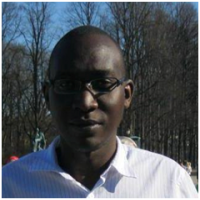
Student Short Biography:
Kennedy K. Ronoh graduates with PhD in Computer Science at the 63rd Graduation ceremony of the University of Nairobi on 25th September, 2020. Ronoh is a Lecturer at Technical University of Kenya at Department of Communication and Computer Networks. He is also the Academic/Research Team Leader for the department. Ronoh received his Masters in Electrical Engineering (Wireless Networks and Electronics) from Linkoping University, Sweden in 2012 and Bachelor of Technology in Computer Engineering from Moi University in 2008. He is a member of IEEE and registered engineer with Engineers Board of Kenya. His current research interests are Internet of Things (IoT), TV white spaces, cognitive radio, metaheuristic algorithms, and wireless community networks. He also serves an Expert Moderator for the Internet Society. Ronoh recently received a research grant worth KSh. 1.5 million from KENET to establish an Internet of Things (IoT) research lab at Department of Communication and Computer Networks at Technical University of Kenya. Ronoh was recently in a taskforce established jointly by Communication Authority of Kenya and Strathmore University to develop regulatory framework on the use TV white spaces for rural broadband in Kenya.
Project Summary
Thesis / Project Title: Resource Allocation in TV White Space Network Using a Novel Hybrid Firefly Algorithm
Thesis / Project Abstract:
There is continued increased demand for dynamic spectrum access of TV White Spaces (TVWS) due to growing need for wireless broadband. Some of the use cases such as cellular (2G/3G/4G/5G) access to TV white spaces (TVWS) may have a high density of secondary users (SUs) that want to make use of TVWS. When there is a high density of secondary users in a TV white space network, there is possibility of high interference among SUs that exceeds the desired threshold and also harmful interference to primary users. Optimization of resource allocation (power and spectrum allocation) is therefore necessary so as to protect primary users against harmful interference and to reduce the level of interference among secondary users. Existing resource allocation optimization algorithms for a TVWS network ignore interference among SUs, use algorithms that are not computationally efficient with regard to running time or apply greedy algorithms which result in sub-optimal resource allocation.
In the study, an improved resource allocation algorithm based on hybrid firefly algorithm, genetic algorithm and particle swarm optimization (FAGAPSO) has been designed and its performance analyzed for power allocation, spectrum allocation as well as joint power and spectrum allocation. FAGAPSO is a hybrid firefly algorithm that uses final solution of PSO as its initial solution and applies particle swarm optimization concept of pbest and gbest in firefly movement as well as genetic algorithm’s concept of crossover. A continuous optimization version of FAGAPSO has been applied for power allocation while a binary optimization version of FAGAPSO has been applied for spectrum allocation. A binary-continuous optimization version of FAGAPSO has been applied for joint power and spectrum allocation. For joint power and spectrum allocation, firefly algorithm was modified to solve a binary-continuous optimization problem since power allocation is a continuous optimization problem while spectrum allocation is a binary/discrete optimization problem.
Simulation was done using Matlab. The simulation environment in Matlab was developed from scratch. Cellular network offload to TV white spaces use case was considered. TVWS channels available in Nairobi CBD were considered in the simulation setup. Simulation results show that, compared to firefly algorithm, particle swarm optimization and genetic algorithm, the hybrid algorithm is able to improve the primary user signal to interference noise ratio, secondary users sum throughput and secondary users signal to interference plus noise ratio in a TV white space network. Only one algorithm considered, Spatial Adaptive Play, has better primary user signal to interference noise ratio, secondary user sum throughput and secondary user signal to interference noise ratio in a TV white space network but it has poor running time.
Links
Student’s Google scholar link
(affiliated to student’s university email)
https://scholar.google.com/citations?user=YhBYKjEAAAAJ&hl=en&oi=ao
Other relevant academic links
https://www.researchgate.net/profile/Kennedy_Ronoh2
https://staff.tukenya.ac.ke/index.php?r=portal/profile/public&id=1658
